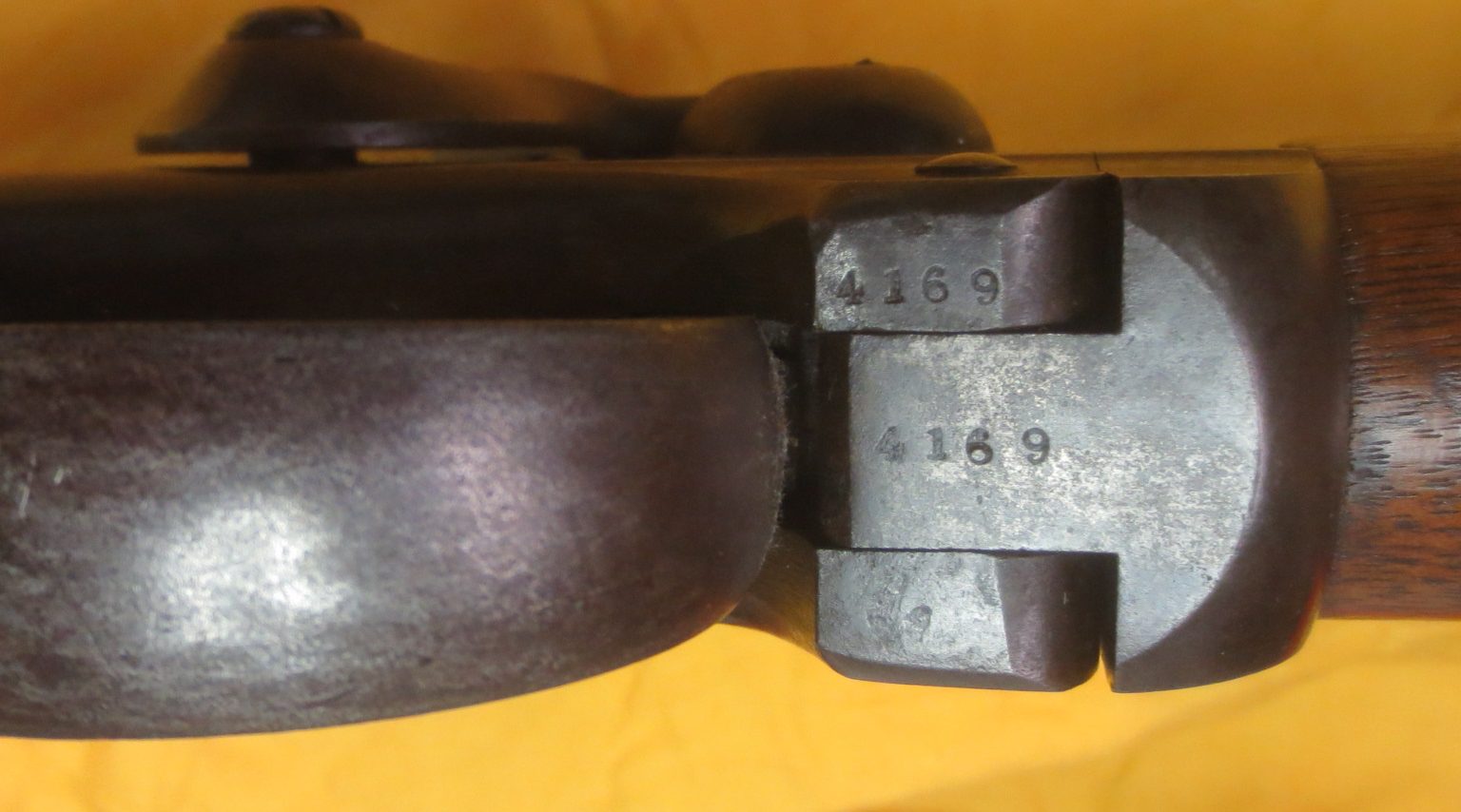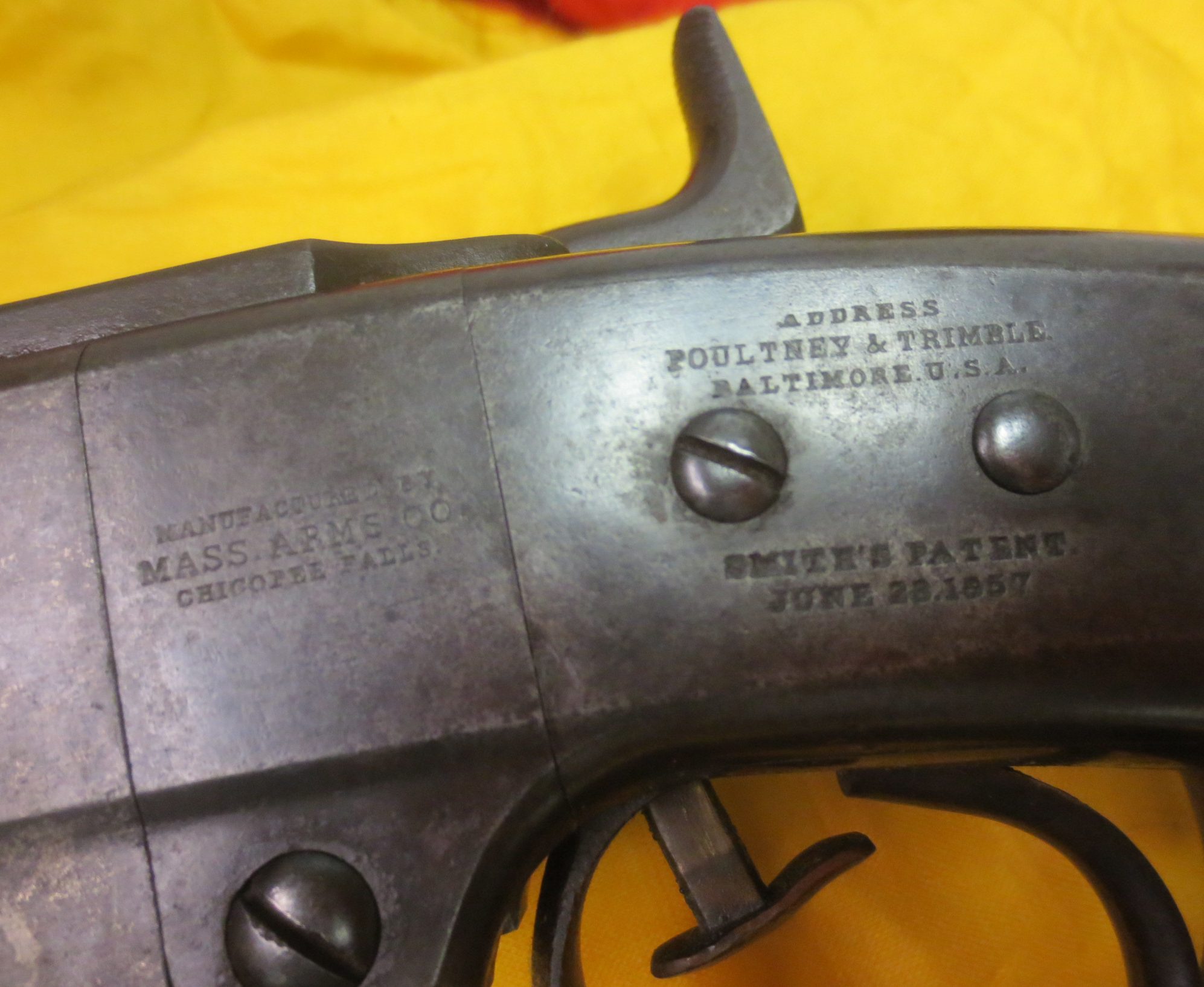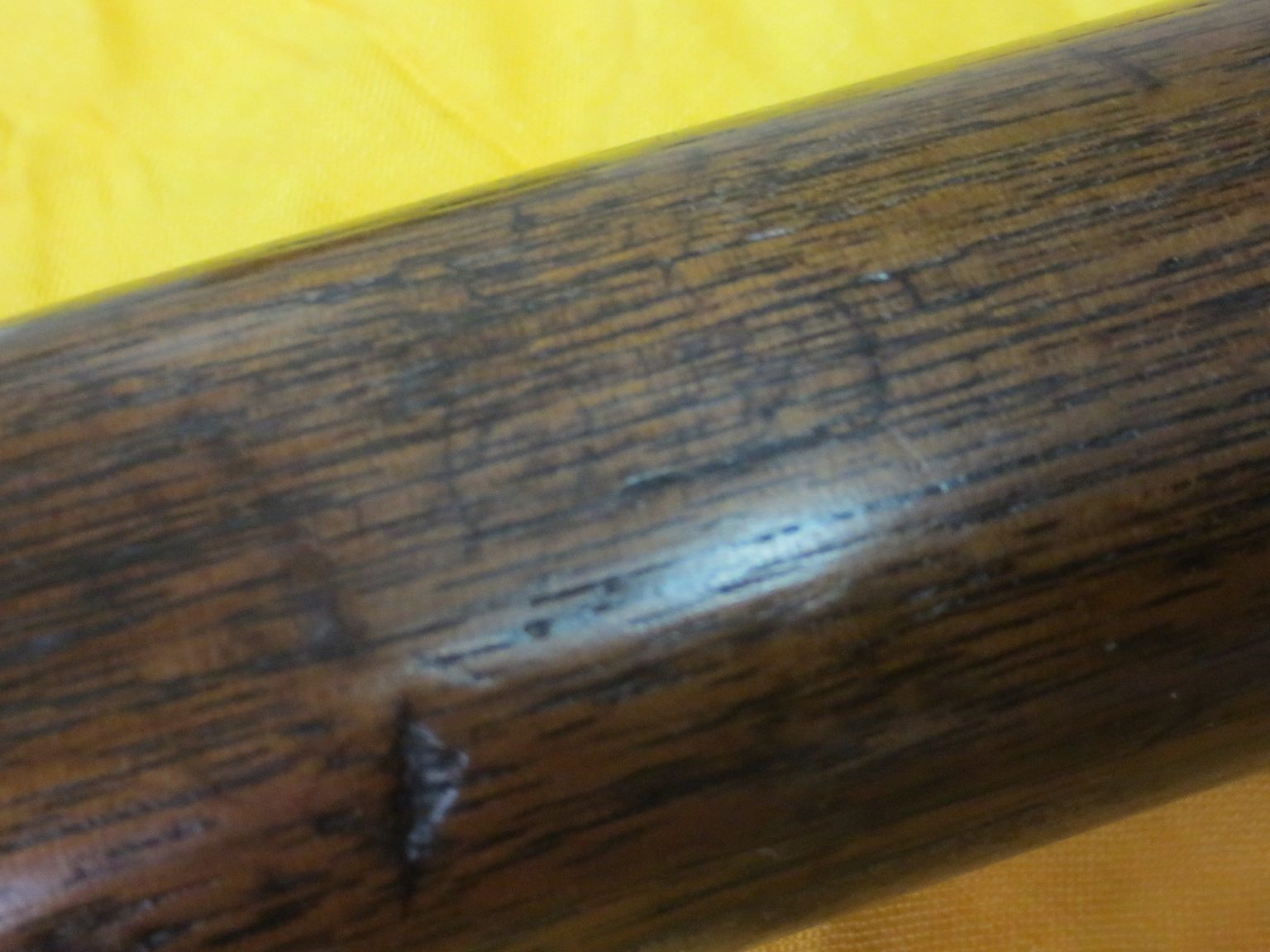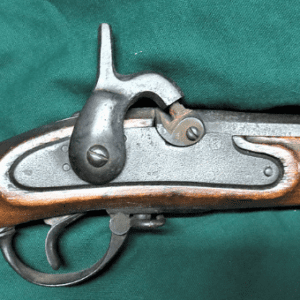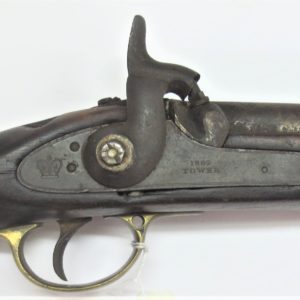Description
Original single-shot percussion carbine, .50 caliber breechloader invented and patented by medical physician Dr. Gilbert Smith of Buttermilk Falls, New York in late 1855. This fine original weapon measures 38½” long overall and weighs a hefty seven pounds and eight ounces. The two piece black walnut stock is made up of a 9” forearm held by a single barrel band. The weapon retains a slightly faded and worn single, rectangular inspector cartouche on the left side at wrist. It has normal dings and dents from field use and age with the largest ding being on the left side of the forearm—a vertical depression almost an inch long which looks almost like a sabre gouge!
The 21 5/8” long blued barrel is round / octagonal-shaped. The entire barrel surface is in very good to fine unmolested condition other than for some light rust oxidation on the barrel band and butt plate. All original front and rear sight. Inspector markings “J.H.” visible on the barrel at the left facet near the frame. Frame is stamped with serial number “4169”. Left side of frame opposite the hammer and over the two lock screws bears a patent mark “ADDRESS / POULTNEY & TRIMBLE / BALTIMORE U.S.A.” Directly beneath is the patent mark “SMITH’S PATENT / JUNE 23, 1857”. Maker’s stamp is located on same side to the left and reads “MANUFACTURED BY / MASS ARMS CO./ CHICOPEE FALLS.”. This early model of carbine, often called the “artillery model,” has no sling bar or sling but does have two iron swivels, one integrated at the front barrel band and the second at the toe of the stock. All of these were, in fact, issued to Cavalry regiments. Frame hinge pin has slight wear. All stampings are very clear and sharp. All furniture is iron and finished blue which has turned to a mellow plum brownish patina. Carbine exhibits crisp mechanics. Bore with six-groove rifling is very good and will clean to bright.
Identical weapons numbered #4168 and #4173 are noted by Springfield Research Service to have been issued to Company D, 2nd West Virginia Cavalry so this one (#4169) is almost certainly one from that same unit.
The 2nd West Virginia Cavalry, although mustered into the service as a West Virginia unit, was recruited mainly in Ohio. It was organized August 1, 1861, in Southern Ohio by Colonel William M. Bolles. Ohio’s Governor declined the muster of the Regiment, stating he was under orders to commission no more cavalry. Application was made to Governor F.R. Pierpoint, provisional Governor of the portion of Virginia now known as West Virginia. With the consent of the Secretary of War, Pierpoint accepted the organization and ordered it into camp at Parkersburg. It was mustered as the Second Regiment of Loyal Virginia Cavalry on November 8, 1861. The Regiment operated about Western Virginia until July 1864 when it moved to the Shenandoah Valley. It fought at Kearnstown, Chambersburg, Opequan, Fisher’s Hill, Cedar Creek, Five Forks, Sailor’s Creek, Appomattox Station and was at Appomattox during the surrender of the Confederate Army. The Regiment led the Army of the Potomac in the Grand Review at Washington. It then travelled to Wheeling and was mustered out on the 4th of July 1865.
2nd Regiment West Virginia Cavalry. Organized at Parkersburg, W. Va., September to November, 1861. Attached to District of the Kanawha, W. Va., to March, 1862. Unattached, Kanawha Division, W. Va., to September, 1862. Unattached, District of the Kanawha. Dept. of the Ohio, to January, 1863. Unattached, 3rd Division, 8th Army Corps, Middle Department, to June, 1863. Scammon’s Division, W. Va., to December, 1863. 3rd Brigade, 3rd Division, Army of West Virginia, to April, 1864. 1st Brigade, 2nd Cavalry Division, Army of West Virginia, to June, 1864. 3rd Brigade, 2nd Cavalry Division, Army of West Virginia, to July, 1864. 2nd Brigade, 2nd Cavalry Division, W. Va., to November, 1864. 2nd Brigade, 2nd Division, Cavalry Corps, Middle Military Division, to February, 1865. 3rd Brigade, 3rd Division, Cavalry Corps, Army of the Potomac, to June, 1865.
SERVICE.–Ordered to Guyandotte, W. Va., December 15, 1861, and duty there till April, 1862. Cooperate with Garfield against Humphrey Marshall January 7-8, 1862. Dry Fork, Cheat River, February 8. 1st Battalion (Cos. “B,” “C,” “F,” “H” and “I”) moved to Meadow Bluff April, 1862. 2nd Battalion (Cos. “A,” “D,” “E,” “G” and “K”) moved to Raleigh with General Cox engaged in scouting and operating against bushwhackers in Raleigh, Fayette and Wyoming Counties till August, then rejoined Regiment. Demonstration on Virginia & Tennessee Railroad May 10-18. Lewisburg May 12. Princeton May 15-17. Retreat to Flat Top Mountain May 18. Jackson River Depot May 20. Lewisburg May 23. Raid to Shaver River May 30. Lewisburg May 30. Middle Creek June 8. Alderson’s Ferry June 9. Wolf Creek July 10. Lamb’s Mill July 15. Blue Sulphur Springs July 20. Alderson’s Ferry July 23. Williamsport July 28. At Meadow Bluff till August. Ordered to Kanawha Falls August 14. Shady Springs August 28 (Detachment). Campaign in Kanawha Valley September 6-16. Barboursville September 8. Fayetteville September 10. Cotton Hill September 11. Loop Creek September 11. Hurricane Bridge September 12. Charlestown September 13. At Point Pleasant to October 20. Moved to Charlestown October 20, thence to Camp Piatt. Expedition from Summerville to Cold Knob Mountain November 24-30. Lewis Mill on Sinking Creek November 26. Peters Mountain Raid January 5-20, 1863. Scout into Wyoming County February 5-8. Expedition into Pocahontas County February 10-12. Scout through Boone, Wyoming and Logan Counties March 12-16. Expedition through Logan and Cabell Counties April 3-6. Mud River April 5. Lewisburg May 2. West Union May 6. Summerville May 12 Fayetteville May 18-20. Scout on Big and Little Coal Rivers June 18-19. Loup Creek June 26 (Cos. “B” and “I”). Raleigh July 4. Expedition from Fayetteville to Wytheville July 13-25. Shady Springs July 14. Wytheville July 18-19. Fayetteville July 28. Cold Springs Gap August 5 (Detachment). Scouts from Camp Piatt September 11-13. Smythe County September 14. Scout to Boone Court House October 21-22. Expedition from Charlestown to Lewisburg November 3-13. Little Sewell Mountain November 6. Capture of Lewisburg November 7. Muddy Creek November 7. Near Union November 8. Scammon’s Demonstration from the Kanawha Valley December 8-25. Meadow Bluff December 11. Lewisburg and Greenbrier River December 12. Scout in Cabell and Wayne Counties March 16-18, 1864. Averill’s Raid on Virginia & Tennessee Railroad May 5-19. Princeton, Grassy Lick Cove, near Wytheville, Wytheville, Ingle and Cove Gap May 10. Salt Pond and Pond Mountain Gap May 13. Hunter’s Raid on Lynchburg, Va., May 26-July 1. Staunton June 8. Newport June 10. Lexington June 11. Near Buchanan June 13. New London June 16. Otter Creek June 16. Diamond Hill June 17. Lynchburg June 17-18. Liberty June 19. Buford’s Gap June 20. Catawba Mountains and near Salem June 21. Cove Gap June 23. Snicker’s Ferry July 17-18. Carter’s Farm July 20. Newtown July 22. Kernstown, Winchester, July 24. Martinsburg July 25. Hagerstown July 29. McConnellsburg, Pa., July 30. Hancock, Md., July 31. Near Moorefield August 7. Williamsport August 26. Martinsburg August 31. Bunker Hill September 2-3. Near Bunker Hill September 5. Near Stephenson’s Depot September 5. Darkesville September 10. Bunker Hill September 13. Near Berryville September 14. Battle of Winchester September 19. Fisher’s Hill September 22. Mt. Jackson September 23-24. Forest Hill or Timberville September 24. Piedmont September 25. Brown’s Gap September 26. Weyer’s Cave September 26-27. Battle of Cedar Creek October 19. Dry Run October 23. Nineveh November 12. Rude’s Hill, Front Royal, November 22. Expedition to Gordonsville December 19-28. Liberty Mills December 22. Jack’s Shop, near Gordonsville, December 23. Near Ashby’s Gap December 27. Sheridan’s Raid from Winchester February 25-March 25, 1865. Mt. Crawford February 28. Waynesboro March 2. Charlottesville March 3. Augusta Court House March 10. Haydensville March 12. Beaver Dam Station March 15. White House March 26. Appomattox Campaign March 28-April 9. Dinwiddie Court House March 29-31. Five Forks April 1. Namozine Church and Scott’s Corners April 2. Jettersville April 4. Sailor’s Creek April 6. Stony Point April 7. Appomattox Station April 8. Appomattox Court House April 9. Surrender of Lee and his army. Expedition to North Carolina April 23-29. March to Washington, D.C., May. Grand Review May 23. Mustered out June 30, 1865. Regiment lost during service 4 Officers and 77 Enlisted men killed and mortally wounded and 115 Enlisted men by disease. Total 196.



